You grab a cup of coffee (or tea, if you’re anything like me) and you open your inbox.
Big Mistake.
(closes laptop immediately – hope it self-destructs),
DOZENS of emails.
Some are from clients or a colleague or two… the majority though, are from various businesses trying to get you to open their emails.
In other words, 90% of it is spam.
Every day we see between 4,000-10,000 messages (RedCrow).
That number includes text messages, emails, ads and phone calls; dozens or hundreds of people and brands trying to get us to take some sort of action.
So how do you filter through the noise?
Or better yet, how does your customer do it?
How does she decide which emails to open and which to trash without even taking a glance? How do you make sure she opens your email and takes action?
The answer is (obviously), by providing her with the content that she wants, when she wants it.
The magic behind sending emails that convert --> Providing Value Click To Tweet
That’s what we’re here to talk about today. How I plan, create, and optimize our clients’ emails and our own. I’ll walk you through the exact process I use and show you examples of good emails from other brands, as well as explain how they send emails.
Ready to get started?
First things first, if you’re wondering why email even matters or why you should be optimizing your campaigns, here are a few numbers for ya:
- Email marketing continues to be one of the highest converting traffic sources and the most effective source for nurturing leads (57%).
- In fact, according to the McKinsey report Email is 40 times more effective at acquiring new customers than social media.
- And delivers the highest Marketing ROI of all channels.
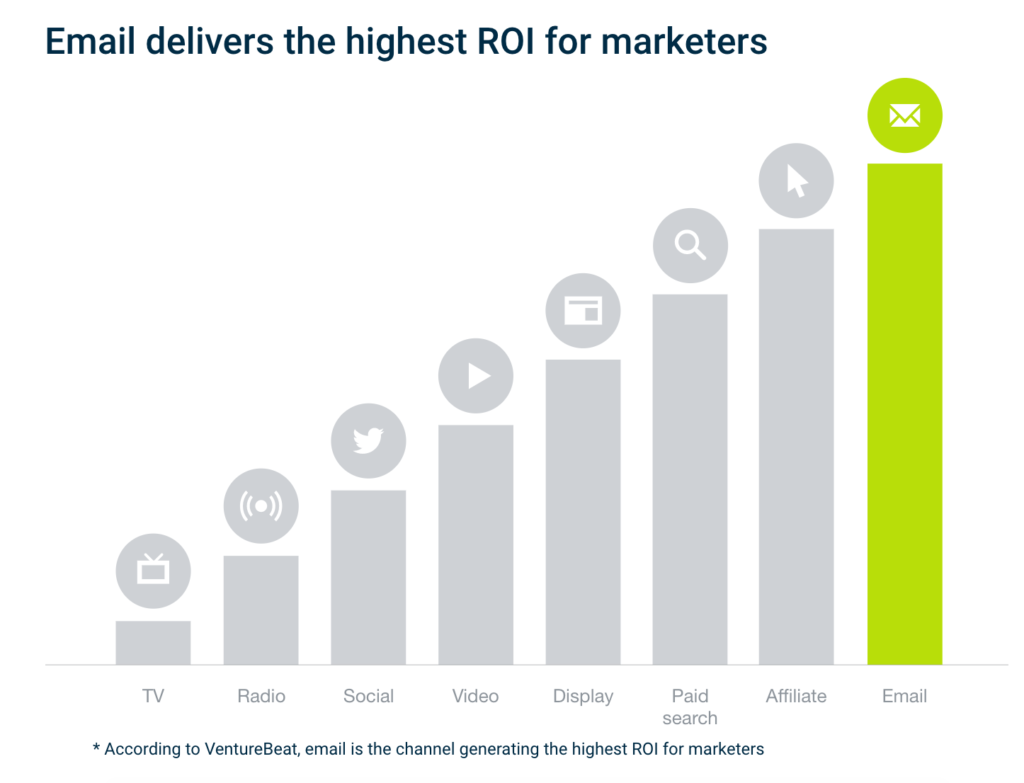
Source: Campaign Monitor
So now that it’s settled that email matters, let’s get down to business and discuss exactly what you need to do to create attention-grabbing emails that your customers will love to open, click and convert to.
Table of Contents
10 Rules for Writing Really Good Emails that Convert
#1 Define Your Reader
Not all readers are created equal. Not everyone is your customer, and you’re certainly not writing for everyone.
Identifying your exact target audience for each email is imperative. You have to know who you’re talking to, how you’re going to write for them, what language to use and how to reach them.
The more segmented the audience, the better the results. As Campaign Monitor’s research shows, segmented campaigns drive 760% more revenue for businesses. Our customers want to receive relevant emails that are personalized to them.
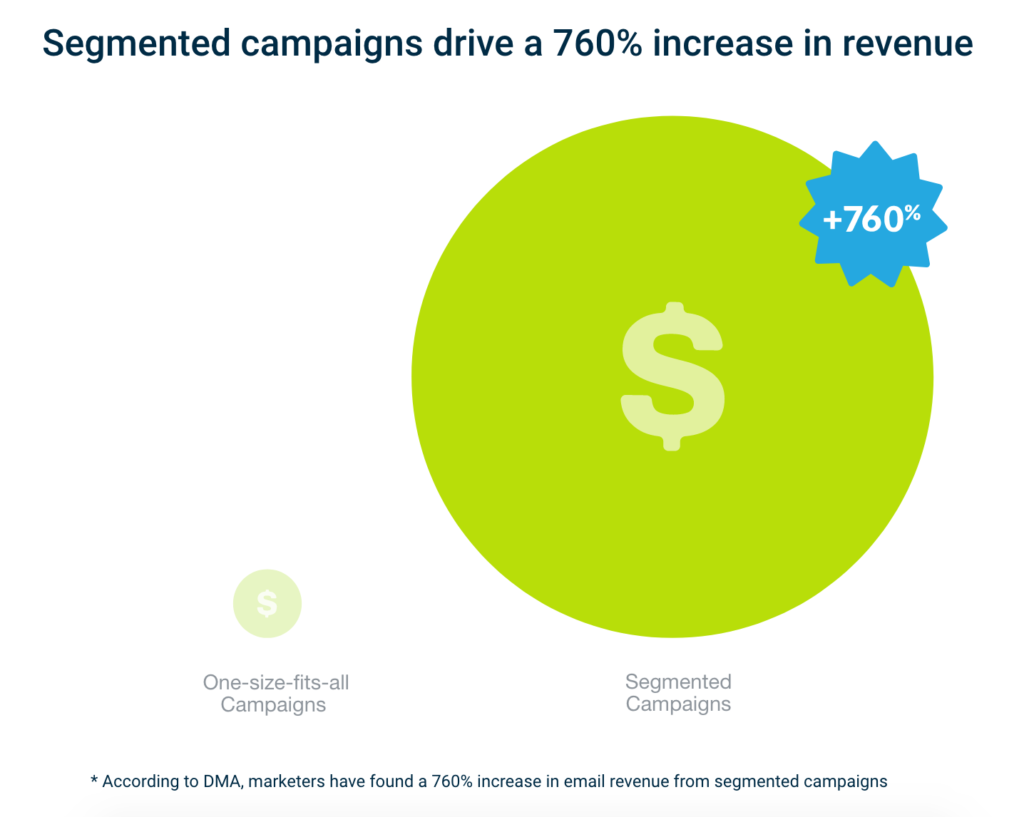
Source: CampaignMonitor
So how does segmenting your audience and knowing who they are drive those amazing uplifts in your emails? Simple. Knowing your readers allows you to:
- Use the language your audience is familiar with
- Use the tone of voice they feel comfortable with
- Tell stories they will resonate and connect with
- Highlight what matters to them
- And segment your audience within your email platform
To do all that you must know your reader, I mean, really know them. Here’s how to do that:
- Interview your customers. Get to know them. It’s not about asking why they chose your platform; it’s about listening to them. It’s not enough to just send out a questionnaire. Get on the phone and speak to them.
- What language do they use?
- What terms do they use to describe your solution?
- What values do they hold most sacred and what matters to them?
- Read the reviews. On your site and on your competitor’s, find out what’s bugging them, what is most important to them and what keeps them up at night. The answers are all there waiting to be swiped by you. These are entire paragraphs and sentences written about you and your industry, use them.
- Interview your staff. Talk to those who talk to your customers. Ask them the hard questions, see how they align with your customer’s answers. Talk to anyone who has some kind of touchpoint with your customer – the retention team or perhaps the sales team. A great question to start with is: “If our brand was a person, what kind of personality would it have?”
- Find common questions. Review platforms such as Quora, Twitter and forums around your industry to see what people are asking, what they don’t understand and what they’re missing.
- Pro tip: Turn questions into titles or testimonials. Once you’ve identified repeating questions, answer them from within your text.
Once you know who you’re writing for and what your purpose is (why you’re writing this email), you can take the next step…
#2 Identify Your Reader’s Goal
Your emails (and hopefully your entire business) should be all about solving your customer’s needs and helping them fulfill their goals. Everyone has a goal, something that drives their everyday behavior, things they are trying to achieve, that make them who they are and define how they live their lives or why they do what they do for a living. These goals are what drive our customer’s decision-making process (amongst other things), and while most marketers focus on what their own goals are, the correct way to start is by asking yourself – What is my audience’s goal?
Every customer that arrives on your site is searching for a solution to a problem, whether it’s to find something to wear on a date or solve a communication problem within their team. If customers can fulfill their own goals with your solution, that means you achieve your own.
Once you define your customers’ goal, it will be easier for you to craft your emails and write compelling messages that resonate with your readers and motivate them first to open your email, click through, and ultimately convert.
To define your customer’s goals:
- Ask them what they are. Don’t assume you know what it is. As I mentioned in the first step, nothing beats a 1:1 interview with your customer. However, note that customers rarely know what they want or why they want it. As Jen Havice mentions in her article ‘How to Build High Converting Sales Funnels your Customers’ Will Love,’ to get the real and authentic answers, you must keep asking why until there are no why’s left.
- Other ways to identify your customer’s goals include:
- Reviewing customer surveys
- Listening to call logs (if available)
- Analyzing customer reviews
- And looking at existing data within Google Analytics
#3 Write the Outline
Creating an outline of your email before you start writing will prevent you from making many mistakes: having overlapping messages, forgetting to mention something or saying it too many times. I know, it sounds like I’m telling you to spend more time on creating emails, but writing the outline of your email will save you a lot of time and:
- Ensure you include everything you need to
- Give you a clue of the information/data you may be missing
- Help you write the entire email in one session (forget about writer’s block or, “I’ll get back to this after lunch.”)
- Help you plan future emails that correlate with each other
Writing outlines for emails makes you a productive writer. Once created, it is far easier to deliver a high quality message to your reader.
The way you present and organize the information for your email in advance will dictate its results and impact. This visual representation of your email structure saves you a lot of time in editing, rewriting and ensures you write clear and concise emails.
Elements of the outline include:
- The primary purpose of the email
- Details of your target audience
- Your customer’s main pain
- What the pain makes them feel
- What your solution offers
- Other key points
- A call to action
- When the email will be sent
- We’ll get into further details about #3-5 later on.
#4 Choose A Good Subject Line For Emails
Ah, the subject line. A single element that determines whether people open and read your email or trash it without even giving it so much as a glance.
- Side note: It is important to point out that while the above statement is true, other factors determine if someone opens your email or not. For example, the “sent from” name and how familiar you are to your readers. Think about it, how many times have you opened an email with a terrible (not to mention dreaded) subject line just because someone specific sent it to you?
Back to our subject line. It is one of the most important elements that not only ensure your email gets opened, but read and clicked on.
I know most people like to discuss high converting subject lines concerning the word count, however through years of testing and my personal experience, I’ve seen time and time again that it’s rarely about the length.
Think of subject lines just like any other sales funnel; it’s not just about the open (or click on the ad.) It’s about moving people throughout the stages of the funnel: from reading that email to clicking on that CTA and continuing the customer journey.
![]()
![]()
![]()
Each one of these emails had a very high open rate, click through rate and most importantly, very high conversions. Subject lines aren’t there to make people open an email; they’re there to make you want to read it.
Subject lines aren’t there to make people open an email, they’re there to make them want to read it Click To Tweet
There are many different types of subject lines you can use and certain formulas that work better than others. The key to using them correctly is completing the first steps we discussed, (e.g., getting to know your audience) and then testing it out on a segment of that audience.
Examples of Subject Line Formulas Made to Convert:
- Use Urgency – Urgency is one of the most compelling aspects of human psychology. “Last call for the alpaca sale” or “This amazing offer is about to finish” are common strategies you’ll see marketers use. People have a real fear of missing out, which is why we buy all sorts of products and solutions that we don’t necessarily need.

- Personal Connection – If you’ve felt the same pain as your customers, you can write subject lines that build trust and peak curiosity like our most successful subject line: “I used to make ALL the common mistakes optimizers make with their websites”
![]()
- Lists – People love lists. You’ll see this method used a lot in blog posts: “150 ways to mow your grass” and “25 cheats you didn’t know about in SIMS”. The longer the list, the better. People love to skim through these posts and find one or two examples hey can use. If I were to follow my own advice here, this week’s subject line would say: “11 Steps for planning, writing and sending emails that convert.”
![]()
- The Freebie Email – I spend a lot of time creating templates, worksheets and checklists for my readers which is why many of my subject lines will read: “The DIY landing page optimization guide → download these free worksheets” (those worksheets are here by the way.)
- Ask a Question – An excellent way to engage readers from the get-go is by asking a question from within the subject line. Joanna at CopyHackers did this well with her subject line “Do you think copywriting is an art?”. The email asked people to leave a comment on their landing page and got people engaged with each other.

- Answer a Question – Answer your reader’s most desired questions, for example: “Here’s why your emails aren’t converting” or “How to remove the background of your image in Photoshop.”
- The“What if” Subject Line: These types of subject lines grab the reader’s attention and have readers clicking away to find out the one truth they haven’t considered: “What if I told you, you could become a Jedi master?” or “What if you’ve been doing Facebook Ads wrong this whole time?”
- “This Authority Figure Just Said…” Subject Line: When someone we know, look up to or appreciate says something important, we tend to listen and take action. Example: “Rand Fishkin just said SEO is dead” I’d totally open that email.
You won't believe what @randfish just said' (and other high-converting subject lines you should test) Click To Tweet
- Social Proof subject line: As Andy Crestodina once said: “When you say it, it’s marketing. When your customer says it, it’s social proof.” Social proof is a way of selling, without actually selling. There’s a reason ecommerce reviews are imperative to sales; we don’t have to know the people testifying to the company’s success – we just want to know people are. Example: “890 marketers are already reading Hacking Growth, what about you?” or, “Talia’s course helped us get a 20.3% conversion lift” (yes, that is a real testimonial.)
- The Personal Subject Line – As you’ve probably noticed by now, I write from my own POV (point of view). Some businesses use a more serious tone and voice, I write more intimately; that’s just the way I am. I often share personal stories too, like last week when I shared how my friends and I almost got stuck on the wrong cruise. Sometimes an individualized subject line can grab your reader’s attention. Example: “I just got back from Thailand and have so many insights to share.” or “5 things I learned about fishing this weekend”.
- The Revealing Subject Line – There’s nothing more authentic than someone revealing they made a mistake. At times it can also be comical. These types of subject lines increase the reader’s curiosity and can deliver great results. A few weeks ago I received the following subject line in my inbox from someone I didn’t know: “I just made avocado pasta. Big mistake” Yep, I definitely opened that one.
The best way to approach subject lines is by treating them the way marketers approach blog headlines: think interesting, think valuable and think big.
#5 Write A Compelling Story
Ok, so you’ve mapped out who your audience is, what interests them and what you want to say. It’s time to write the actual email.
There’s no need to reinvent the wheel. Copywriting formulas have existed for many years, and you can use them to craft your email. Rather than sitting in front of a blank page and hoping the perfect email will come to you, use one of these two formulas to craft the perfect email. What’s great about these formulas? Once you write the first sentence, everything else just falls into place.
Formula #1: PAS
PAIN
AGITATION
SOLUTION
Start by writing down the following:
- What is your customer’s pain?
- How does this pain affect them?
- How do you solve it?
The PAS formula is one of the most popular ones due to its simplicity:
Pain: Lead with the pain they’re experiencing,
Agitation: Explain how it deeply affects them and then finally,
Solution: Introduce a solution.
If we focus on our customer’s pain and remind them how they feel, we can then offer the solution and get them to take action.
Let’s take look at a recent email I wrote for our Mobile Optimization article to see this in practice:

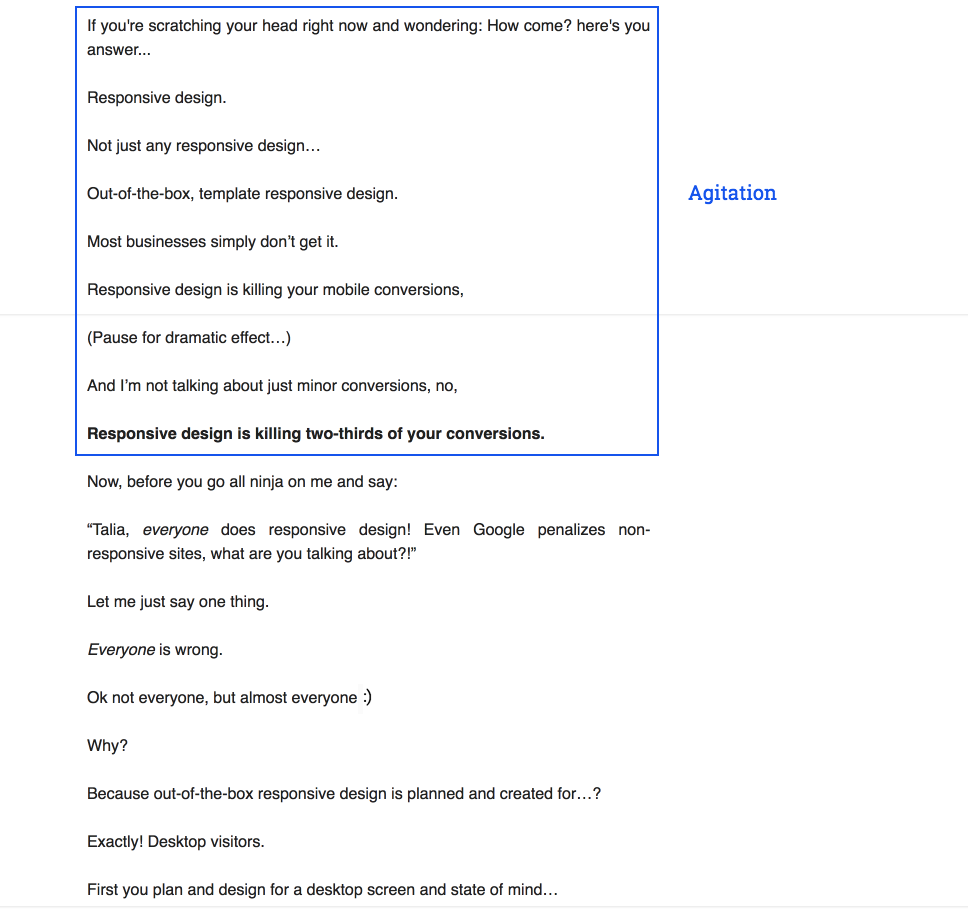

As you can see, PAS is quite a simple formula for writing emails. Once you know the pain of your customer, how it affects them (agitation) and what your solution is, that email should practically write itself.
Formula #2: AIDA
- Attention – Grab their attention quickly.
- Interest – Tell them something that intrigues them, something they may have never heard before, or something that goes against what they would normally do.
- Desire – Engage them in a way that leaves the reader wanting what you have to offer.
- Action – Ask them to take action.
Let’s look at this formula in action:
As Joanna Wiebe explains so very well here, AIDA is a simple formula most businesses use without even knowing it. The one thing they usually don’t include is ‘Desire’.
Businesses find it easier to grab people’s attention, interest them and of course ask them to take an action, but rarely do they pique their reader’s desire and make them want what they have to offer. Why is this formula going to work so well for you? Because you’ve spoken to your customers now, you know what they desire – give it to them.
Once you’ve chosen a formula to write with, you still have to think about how you’re going to say what you need to say. What I mean is that you can use these formulas in a technical way that won’t serve your purpose.
This isn’t what we’re going for. What we want is to write emails that resonate and connect with our audience. You do that by telling stories.
Story Telling:
People have a hard time remembering data, but tell us a good story, and we’ll find ways to relate to it and remember it. The right stories are memorable, personal and engaging. And it’s not just me saying this; it’s science!:
“Brain scans are revealing what happens in our heads when we read a detailed description, an evocative metaphor or an emotional exchange between characters. Stories… stimulate the brain and even change how we act in life.” (NYTimes)
When someone tells us a personal story our brain almost immediately mirrors that story and finds ways to connect it to our own story, we relate to them or have something to say about them instantly.
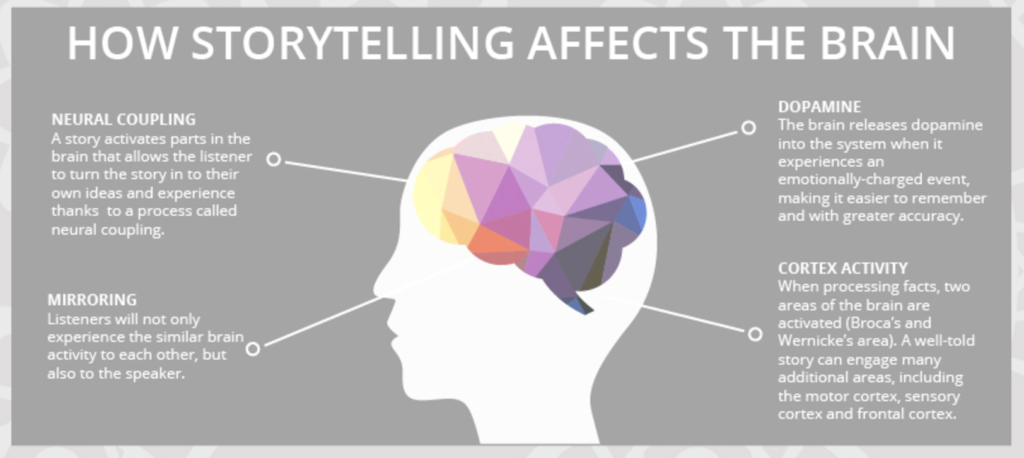
It’s hard to detect emotion in emails and text, and that’s why what you say and how you say it is significant. Use your customer’s words to tell their story in your emails.
Fortunately, you don’t have to make this stuff up; it’s right there in your customer surveys and interviews. They’ve already told you their pains, desires, and concerns. Use their words to remind them and make sure you’re talking to your customers, not at them.
Successful businesses don’t sell products; they sell emotions and better versions of ourselves. Nobody likes to be sold to, we all want to be better parents, managers, more popular, thinner or more successful in what we do. Stories make those desires come true, not products.
Done correctly, the story you tell can increase the customer’s trust in your brand, their loyalty and connect with them further on an emotional level. In short, using the right story, tone and voice will ensure you retain your customers over and over again.
#6 Figure Out The Right Length Of An Email
It’s standard advice that you should write less and use fewer words, because “best practices” show that people don’t read. WRONG. People do read, they just need a reason to.
When it comes to our emails at GetUplift, long emails work. It isn’t to say they always work or that they will work for every email you send out, it’s just something we’ve tested that we’ve seen work. In fact, looking at our reports, more readers tend to click on the link to our articles at the bottom of an email rather than the one given mid-way.
So how do you decide? According to your email’s purpose, your audience’s patience and their interest or desire in what you’re offering. A weekly email to your subscribers will be different in length and content vs. email outreach for example or product updates.
When it comes to sales emails, the key to writing successful long-form copy (that’s the “formal” name of this technique) is writing according to your customer’s awareness level.
There are 5 levels of awareness (we’ve covered this on our blog a few times (here and here). Your goal is to identify that level of awareness and move people towards the next level until they reach the last – ‘Most Aware’. This can be done in one very long email or in a series of emails each addressing one level of awareness and moving the reader onto the next. Let’s look at an example:
Level 1 – Unaware:
If someone is unaware they have a communication problem within their team, your email’s goal is to make them aware of that pain by showing them how it impacts their day-to-day work.
Level 2 – Pain aware:
Now that they’re aware of the pain, you need to tell them there’s a solution for it.
Level 3- Solution aware:
At this level you need to show them what type of solution would help them specifically (aka – your product)
Level 4 – Product aware:
Now they’re aware of your solution; you’ll need to build trust and tell them why you’re the right one for them.
Level 5 – Most aware:
Now they’re convinced, all that’s left is to tell them to take action.
And Voila’ you have yourself either a very long email that includes a few awareness levels or a series of drip campaigns with multiple emails, each addressing a certain level of awareness. Works like magic.
#7 Optimize Your Visuals
The way your emails look also have a huge impact on conversions.
Depending on the purpose of your email (sales, newsletter, lead nurturing, etc.) you can design your email in various ways:
- Using images and colors: There are thousands of email templates out there for you to use. Consider what works best for you according to your target audience and the purpose of your email. One design can have a cleaner look, use a lot of white space, one call to action button and a few lines to break content into sections like Adidas does:
 Another could imitate Bustedtees’ format – emails including large images, a few call to action buttons and a countdown timer to create urgency:
Another could imitate Bustedtees’ format – emails including large images, a few call to action buttons and a countdown timer to create urgency: It is about understanding who your audience is and what appeals to them.
It is about understanding who your audience is and what appeals to them.
A few rules for using images within your email:- Avoid using them as background. Most email clients do not support that, and it won’t show up at all in their inbox.
- QA on mobile – most people read emails on their mobile phone.
- Align images to the left for easy reading
- For call to action buttons, make sure to use a contrasting color, place whitespace around it and make it appear clickable – people need to understand it’s a button.
- Using gifs, animations, and videos – These are some other great ways to use visuals in your emails. Headspace does an excellent job using a gif with the AIDA formula: Attention and interest in one animated title, a desire for a good night’s sleep and a call to action:


 Source: ReallyGoodEmails
Source: ReallyGoodEmails -
Writing from a single person point of view: At GetUplift, we use an approachable and personal tone of voice. I spend a lot of time writing each email we send out making sure they look, feel and sound exactly like it would if you were having a 1:1 conversation with me in person. Here’s what that looks like:
- All text is aligned to the left
- I use short sentences
- I write our emails as a personal letter from me to my reader
- I rarely have any visuals in our emails
- Our calls to action are in simple text only, no buttons.
- And I highlight important information with either italics or bold.
This is what works for us; it doesn’t necessarily mean it will work for you. You need to understand the tone and voice you want to use and build your emails around that.
#8 Add Email Personalization
Our inboxes are extremely crowded.
So crowded that consumers expect retailers to know their preferences and interests. In fact, a recent survey by Infosys found that 78% percent of consumers are more likely to be a repeat customer if a retailer provides them with targeted, personalized offers.
So how do you do it?
First, start by building segments within your email list. Categorize people according to the data that you have:
- Geographic location
- Job title
- Customers vs. prospects
- Recurring customers vs. one-time customers
- Lifetime cycle
- Age and gender (if that matters to your business)
- Categories bought (group people according to the items they purchased)
Your goal is to first build your segments according to the data you have, only then do you personalize the content within the emails you send to each segment.. More on the topic of segmentation can be found in Hull’s brilliant article: Secrets of Segmentation.
So you’ve built the segments, now what? What can you do to personalize your emails beyond the “Hi Marc”? Lots.
- Use location and time – Instead of sending your emails to everyone at the same moment, send your emails out to people when it’s the most reasonable for them to open them. Mailchimp offers the Timewarp feature which allows you to configure your email to be sent at 9:00 am for each person in their timezone.
- Utilize special dates and events – Send personalized emails on important dates such as their birthday or anniversary. Also, send specific suggestions and offers on special holidays.
- Send personalized offers – according to previous purchases
- Send relevant tips – Send tips on how to better use the products or solution they purchased from you
- Send relevant updates – Update them on their progress within your platform or the status of their purchased product.
In their annual email, Grammarly offers a summary of your use and an invite to upgrade to a relevant plan according to your specific needs:

Lyft personalizes their emails according to geographical location:

#9 Test Your Emails
Last but not least, testing. Yes, good ol’ testing.
The most common practice for AB testing is subject lines, which is good but it’s not enough.
If you want to create emails that convert, whether sales emails, newsletters, or even onboarding emails, you have to run meaningful tests that can help you optimize each email you send.
Before running your tests, a few things to consider:
- Every test should have a goal – know what you’re going to test and why.
- Try to steer away from testing more than two variants per email.
- Determine the results of the test according to action (clicks) rather than open rate.
- Try to have a minimum of 1500 people on each variable to get conclusive results.
- Keep testing the same thing over and over. There aren’t any guarantees the same strategy will work over and over again just because it worked once.
When testing, consider strategy. It’s not about the one time win; it’s about proving over and over again that a particular approach works.
Here are a few testing ideas for you to consider:
- What days and times work best for your target audience?
- What type of subject lines work best?
- Long descriptive vs. short and to the point
- Personal vs. serious tone
- Do incentives or teasers get more open or click rates?
- From name – What works better?
- Just me: Talia Wolf
- Who I am: Talia at Getuplift
- Company name: GetUplift Team
- Text link vs. button: Are people more likely to click on a shiny button or linked text?
- Link placement: Are people more likely to click on a call to action within the first paragraph of an email or further down the email?
- Images: Static vs. video vs. gif – what do your readers prefer?
Test resending your emails to those that don’t open the first time. Using this method you send the same email using a different subject line a few days later.
[BONUS RULE] Before you hit that ‘send’ button:
There’s only one thing left I want to discuss with you before you hit send:
STOP hiding your unsubscribe button!
I cannot stress this enough.
As a reader: There is nothing more frustrating than trying to unsubscribe from an email subscription and having a hard time finding the button or being asked to login to do it.
And if thinking about your customer isn’t going to work in this case, then here’s why business-wise it is a BAD idea to hide that unsubscribe link:
There is NO advantage to doing it.
People who want to unsubscribe from your list are people who aren’t going to convert even if they do “give up” on unsubscribing. They’ve already opted out of your emails mentally. And why do you care? Because keeping those people on, means lower open rates, lower click-through rates, AND high complaint rates about you.
So just stop it.
Thank you.
I’ve laid it all before you. The exact steps you need to take (and how to take them) to create high-converting emails. The bottom line (as usual) is that you have to make it about the customers. You have to write for them.
The best tip I ever received for writing effective emails was this: Write for one person. Think of one person on your list, someone you know well, and write for them. Tell their story and write it in a way that when she opens that email, she’ll know it was written for her.
The best tip I ever received for writing effective emails was this — write for one person. Think of one person on your list, someone you know well, and write for that person. Click To Tweet
–Talia
Facebook Comments
Powered by Facebook Comments

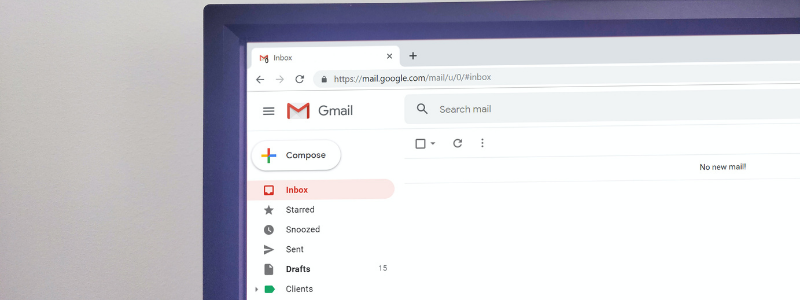




Really nice piece Talia. Well researched.
#1, 2# and 3# are clearly winners.
I like the #7 awareness breakdown. I definitely believe that long form of the bat is a tough way to go. I’ve yet to come across a high converting one at least.
What’s funny for #8 is that before having extensive experience with email marketing, I would have thought that visual is super important but my experience actually tells a different story. This is open for debate, but my few cents is that keeping it simple and avoiding promotions tab brings a better ROI. Admittedly, it depends on brand values and priorities – Mine is inbox every time.
For me #9 is key. We do this at my company with product recommendations.
At Beans we’ve built a loyalty software that helps retailers retain customers. One of the key aspects to our product is sending notifications to these retailer’s customers. Apart from the personalization another key factor and a suggestion for #11 is customization. We allow end users to choose the frequency at which they receive notifications, and putting users in control like this makes a massive difference to how these updates are seen by users.
Hi Evan,
Glad you found the article helpful!
Fantastic comment abut customization. Allowing readers to customize the emails and/or notifications they receive is a great way to ensure people get the content they want, when they want it.
I loved how you shared your simple formula that works and really at the end of the day it’s crafting content that provides value to the reader.
Really well thought out and presented article that is loaded with tips so I was happy to share it in my private online marketing group.
Thanks JoAnne, glad you found the article helpful!
Very helpful. Could you advise in the best software to design the mail. I am struggling with them being responsive in every divice.
Thank you so much
That’s a great question Isabel. Unfortunately most email platforms are seriously lacking mobile solutions and don’t offer good enough templates for mobile. Since over 50% of emails are opened on mobile I’d design for mobile only/first. A few things to consider when you design them:
Think about your font size
Reduce image size (consider removing images entirely)
Think about the way people will be tapping on links (text requires a lot more white space so people don’t tap on the wrong elements)
And build your entire campaign for mobile.
Don’t forget to QA on mobile of course
Thank you so much for writing so clear.full of great examples, I actualy feel you’re sitting near me and teaching me in the person.